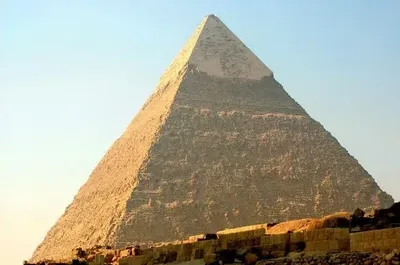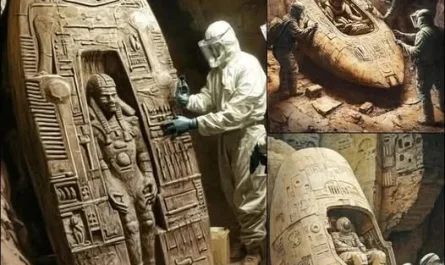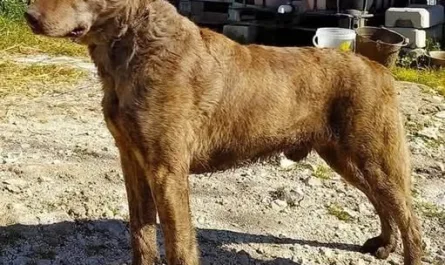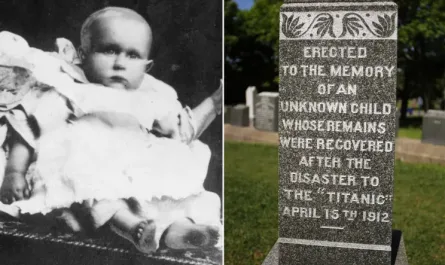Deep in Peru’s Nazca Desert, a 1,700-year-old female mummy adorned with intricate tattoos stands as a captivating relic of the ancient Nazca culture (circa 100 BCE–800 CE). Preserved by the region’s arid climate and displayed at the Maria Reiche Museum, this extraordinary artifact offers a glimpse into the artistic, spiritual, and social world of a civilization renowned for its enigmatic geoglyphs. With tattoos etched on her arms, this mummy is not just a preserved body but a canvas of history, revealing the Nazca people’s traditions and beliefs. Let’s unravel the story of this tattooed mummy and her enduring legacy. 👑💫
A Desert’s Perfect Preservation
Discovered in a tomb overlooking the vast Nazca Desert, this female mummy, dating to approximately 300–500 CE, owes her remarkable condition to the region’s dry, arid environment. The Nazca Desert, with its minimal rainfall and low humidity, acts as a natural preservative, safeguarding organic materials like textiles, skin, and even tattoos for centuries. Combined with the Nazca’s sophisticated funerary practices—such as wrapping bodies in layers of woven cotton and placing them in dry, sealed tombs—this environment ensured the mummy’s tattoos remained vivid.
Housed at the Maria Reiche Museum in Nazca, Peru, the mummy is displayed in a climate-controlled exhibit, protecting her from further degradation. Named after the archaeologist who dedicated her life to studying the Nazca Lines, the museum offers visitors a chance to connect with this ancient figure, whose preserved form bridges the gap between past and present.
Tattoos: Art and Symbolism
What sets this mummy apart are the intricate tattoos adorning her arms, a rare feature in archaeological finds. These designs, composed of geometric shapes, stylized animals, and abstract motifs, showcase the Nazca’s advanced artistic skill. Crafted with precision, likely using tools like cactus spines or bone needles and natural pigments, the tattoos were not mere decoration but held deep cultural significance:
-
Social Status: Tattoos may have marked the woman’s rank, lineage, or role in society, distinguishing her as a person of importance, perhaps a priestess or noble.
-
Ritualistic Meaning: The Nazca were deeply spiritual, with beliefs tied to agriculture, water, and the cosmos. Tattoos could have served as protective charms, offerings to deities, or symbols of connection to the spiritual realm.
-
Identity and Expression: Like the Nazca’s famous geoglyphs, these tattoos may have been a form of personal or communal identity, reflecting tribal affiliations or life events.
The designs mirror the aesthetic of Nazca ceramics and textiles, which often feature motifs like serpents, birds, and mythical beings. This connection suggests tattoos were part of a broader artistic tradition, linking the body to the culture’s visual language.
The Nazca Culture: Artistry and Spirituality
The Nazca people are best known for the Nazca Lines, massive geoglyphs etched into the desert floor, depicting animals, plants, and geometric shapes visible only from the air. Flourishing in southern Peru, their society thrived on agriculture, supported by sophisticated irrigation systems in a harsh desert environment. Their art—seen in pottery, textiles, and now tattoos—reflected a worldview steeped in spirituality, with themes of fertility, nature, and the divine.
The tattooed mummy highlights the Nazca’s use of the body as a canvas for expression, much like their geoglyphs transformed the desert. Tattoos likely played a role in rituals or ceremonies, possibly marking transitions like puberty, marriage, or religious duties. The presence of such detailed body art suggests a society where personal adornment was as significant as monumental creations, tying individuals to their community and cosmos.
A Woman of Mystery
While little is known about the mummy’s personal life, her tattoos and burial context offer clues. She was likely a woman of significance, given the care taken in her burial and the artistry of her tattoos. The Nazca practiced ancestor veneration, and elaborate burials were reserved for those of high status. Her tomb, overlooking the desert, may have been strategically placed to align with sacred landscapes, a common Nazca practice.
The tattoos’ placement on her arms—visible and prominent—suggests they were meant to be seen, perhaps in life during rituals or in death as a lasting mark of her identity. Her preservation allows modern scholars to study not just her tattoos but also her diet, health, and lifestyle through techniques like isotopic analysis, offering further insights into Nazca society.
The Maria Reiche Museum: A Sanctuary for History
At the Maria Reiche Museum, this tattooed mummy is a centerpiece, drawing scholars, tourists, and enthusiasts. The museum, named after the German archaeologist who mapped the Nazca Lines, provides context for the mummy’s discovery, showcasing other artifacts like ceramics and textiles. Visitors can ponder the mummy’s story, her tattoos inviting questions about the woman she was and the world she inhabited.
The museum’s climate-controlled display ensures the mummy’s preservation, balancing public access with conservation. It’s a place where the past feels alive, encouraging reflection on the Nazca’s artistry and the universal human drive to leave a mark—whether on the desert or the skin.
Why This Mummy Matters
The 1,700-year-old tattooed mummy is more than an archaeological treasure; she’s a bridge to the Nazca culture’s heart. Her tattoos speak to a society where art, spirituality, and identity intertwined, echoing the monumental creativity of the Nazca Lines. She challenges us to consider how ancient peoples used their bodies to tell stories, assert status, and connect with the divine.
This relic also underscores the power of preservation. The Nazca Desert’s arid climate and the culture’s careful burial practices have gifted us a vivid snapshot of a lost world. As we gaze at her ornate arms, we’re reminded that humanity’s search for meaning—through symbols, art, and ritual—transcends time.
What do you think the tattoos meant to this Nazca woman? Are you inspired by the idea of body art as a cultural legacy? Share your thoughts below!





